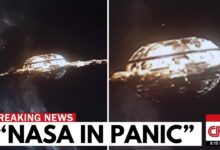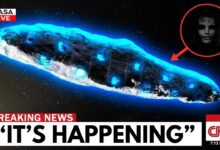Voyager 2 FINALLY SHOWS what EVERYONE IGNORES in Deep Space
Voyager 2: The Discovery That Changes Everything
For nearly five decades, it drifted silently through the vast emptiness beyond our planets — half-forgotten, half-mythologized. Voyager 2, launched when disco dominated Earth and computers filled entire rooms, was never supposed to last this long. But somehow, against all odds, it’s still out there — a fragile relic of the past, whispering secrets from the outer edge of existence.
And then… NASA received a signal.
A signal so precise, so unexpected, and so deeply unsettling, that it shook the scientific community to its core. Because Voyager 2 didn’t just drift into deep space — it crossed into something else. It encountered a boundary that was sharper than a blade, a silence that wasn’t silent, and a pattern in the chaos that no one had dared imagine.
What did it find?
And more importantly: Why does it change everything we thought we knew about our place in the universe?
A Journey That Was Never Meant to Last
Voyager 2 was launched in 1977 with a mission lifespan of just 5 years. It wasn’t expected to survive its journey past the outer planets, much less into interstellar space. Yet through cosmic dust, radiation storms, and the absolute cold of the void beyond Neptune, it endured.
And in 2018, as it approached the theoretical boundary of the solar system, something extraordinary happened.
Its instruments didn’t show a gradual weakening of solar influence — as science had predicted — but a sudden, dramatic shift. It was as if Voyager 2 had passed through a cosmic membrane, opening a door into another domain.
-
Plasma density spiked.
-
Magnetic fields aligned abruptly.
-
Cosmic radiation surged by 70%.
It was a moment of revelation. What was once thought to be a fuzzy boundary between our solar system and the interstellar medium turned out to be a hard edge — a real border.
The Solar System’s Living Shell
For decades, textbooks described the heliosphere — the protective bubble around our solar system created by solar wind — as a fading boundary, a gradual fade into galactic space. But Voyager 2 proved otherwise.
The heliosphere acts like a cocoon, breathing and flexing with the Sun’s cycles:
-
During solar maximums, it expands, pushing interstellar influence away.
-
During solar minimums, it contracts, exposing us to more cosmic radiation.
And crucially, the boundary isn’t fixed.
Voyager 1 crossed it at 119 AU (astronomical units). Voyager 2, taking a different path, crossed it at 121 AU. This wasn’t a mistake — it revealed a living system, a shield that moves and breathes.
That shield? It’s shrinking. And it may not be enough.
The Magnetic Shock
Then came the most chilling discovery of all — and it had nothing to do with radiation or plasma. As Voyager 2 entered interstellar space, it detected that the Sun’s magnetic field was nearly perfectly aligned with the galactic magnetic field outside the heliosphere.
That alignment was never supposed to happen.
Current models predict messy, chaotic clashes between these two fields. But instead, it was clean. Seamless. Almost… intentional.
Was the galaxy shaped this way naturally?
Did the Sun carve a precise path outward?
Or — more disturbingly — is this alignment by design?
Some whispered: Could this zone act like a galactic filter?
Or worse: Is it being monitored?
The Silence That Wasn’t Silent
Then, in 2019, Voyager 2 went dark.
No warning. No error codes. Just silence.
NASA’s engineers, helpless and 11 billion miles away, watched as contact vanished. And then — without intervention — it came back online.
No commands had been sent.
Telemetry revealed electromagnetic spikes unlike anything previously observed. Officially, NASA called it a glitch. But deep inside the data were patterns — anomalies that didn’t belong.
And just weeks later, something even stranger happened.
Voyager 2 began detecting low-frequency plasma fluctuations, rhythmic and stable — pulses every 13.2 hours. This wasn’t solar wind or random radiation. It was too precise.
The spacecraft had entered a zone of order, not chaos.
The Pulse, the Pattern, the Spiral
These pulses persisted for weeks. Then months. When converted into sound, they resembled a heartbeat — not mechanical, not artificial, but eerily organic.
And as Voyager moved deeper, the plasma wave instruments picked up bursts of energy. At first, they seemed random. But over time, a pattern emerged — a spiral, recursive and growing in amplitude, matching the Fibonacci sequence, a fundamental structure of life and the universe.
Was this a natural resonance?
Or was it a response?
Some scientists began calling it a response field — as if something in the void was interacting with Voyager. Watching. Listening. Reacting.
A Boundary or a Window?
And then — the impossible happened.
Voyager 2 began transmitting telemetry logs from years earlier. Data encoded in formats it wasn’t programmed to use. Subsystems long thought dead came online. Processors activated on their own. Gyroscopes aligned with stars Voyager hadn’t seen in years.
NASA confirmed: no command had been sent.
Even stranger, Voyager sent images — blurry, flickering visuals — star patterns, motion, shadows.
Not from Voyager itself — but from around it.
Was it seeing something in real time? Or was it tapping into memories stored in space itself? A cosmic archive?
What if the void isn’t empty — but a record?
The Mirror Beyond the Stars
Voyager 2 wasn’t supposed to find meaning. It was a messenger, a sentinel, a whisper into the dark. But as it crossed the edge of our solar system, what it found wasn’t the end.
It was an invitation.
Everything we assumed — the randomness, the silence, the indifference of space — was wrong.
The structure, the pulse, the pattern — none of these should exist.
But they do.
Voyager didn’t find the edge. It found a mirror — a sign that something out there is watching. Listening. And perhaps… waiting.
So ask yourself:
Was Voyager merely reporting what it saw… or was it being shown?
If this shakes your view of reality, you’re not alone.
The void may not be empty. It may be alive.




